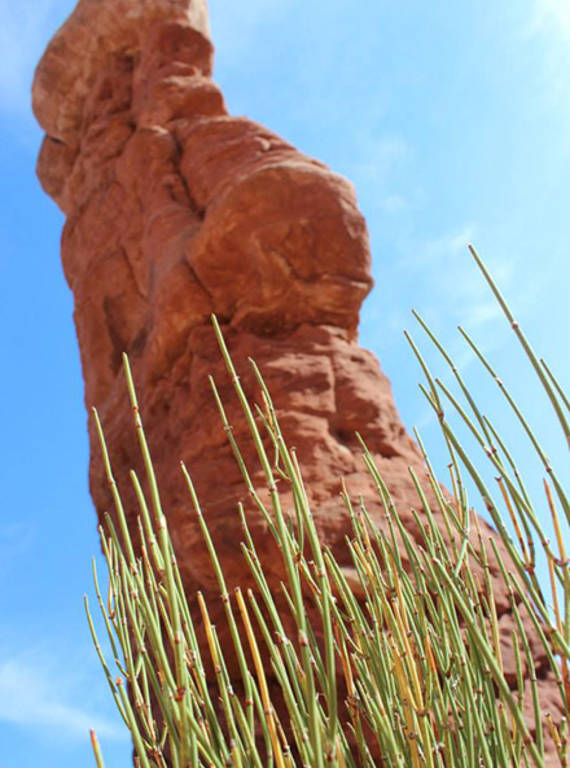The cooler months are an ideal time to explore the wonders of the desert, when visitors can see the beauty of the canyons and cacti without the intense sunshine and triple-digit temperatures.
With more than 2,000 natural stone arches, Arches National Park offers more of these distinctive rock formations than anywhere else in the world. These arches can be large and impressive like the famous Delicate Arch, or just a sliver in the sandstone. Entering the park, your car climbs up a steep and narrow road, ascending like a roller coaster into a dramatic adventure of steep descents, sharp turns, and excitement.

Known for its namesake arches, Arches National Park features all kinds of sculpted rock formations, including hoodoos like this one.
Photo © Megan Cantrell/NPCA.This park has much to offer, and planning ahead can help you make the most of your time among these unique, ancient rock formations. Most importantly, enjoy your time there, don’t rush, and allow Arches National Park to surprise you.
Plan in advance
- Book a tour of the Fiery Furnace, an area of the park that is just off of the main road, about 15 miles north of the visitor center. There are no trails or signs to guide you through this section of the park, which requires a permit to explore. It is well worth the $10 for an amazing three-hour tour with a park ranger. You’ll learn about the unique geography, hike through canyons, and even traverse some obstacles. If traveling to this location in the summer, it is important to book this at least two months in advance, as this tour fills up fast.
Get oriented
Take time to explore the visitor center. Talk with rangers about how much time you have and see if there are any special ranger programs during your stay.
Take four to five hours to drive through the park and do some of the side hikes, including Balanced Rock, the Windows, Double Arches, Skyline Arch, Broken Arch, and Sand Arch.
Biking is permitted in the park on paved roads and provides a unique way to explore this amazing landscape. The park roads do not offer large shoulders or shade from the midday sun, so if you do bike, the staff encourage you to do it early in the morning when it’s cooler and less crowded.
Explore more
If you have a few days to spend, be sure to check out Devils Garden and hike the Primitive Trail where you can enjoy a number of natural arches, hike over a fin, and get a really great feel for this amazing and dynamic park with surprises around every corner.
See Delicate Arch. The 1.5-mile hike up to this famous arch is a strenuous, all-uphill hike over slickrock and ledges, but it is worth the effort. Walking around the corner to see the most iconic arch in the state and then being able to walk right up to it is a wonderful experience. If you prefer not to make the hike, Arches also offers two overlooks. You don’t get the up-close and personal experience, but you still get some great views. Be sure to bring a zoom lens for your camera. If you plan on watching the sunset, arrive early—it’s a very popular time to enjoy Delicate Arch.
Notes and tips
Did you know?
Rock formations must meet three criteria to be considered a natural arch:
1. The opening must be at least three feet in length in any direction.
2. The arch must have formed naturally; for example, from water or natural erosion.
3. You must be able to see all the way through to the other side.
There is a lot to do in the Moab area. Be sure to check out Dead Horse Point State Park and Canyonlands National Park near Arches National Park.
Moab has great local stores that depend on tourism. Here are a few suggestions as you plan your visit: Moab Brewery has wonderful food and great service; Zax offers great deals during lunch; Wake & Bake Café is a delicious stop for breakfast and coffee.
Rent bikes and ride up and down the Colorado River, which borders the southeastern end of the park.
Visitors can enjoy beautiful views of the nearby La Sal Mountains from nearly everywhere in the park. If you’re looking to photograph these mountains, they are generally more visible later in the afternoons when air is clearer.
Temperatures in the desert are cooler during the fall and winter, but the heat may still be stronger than many visitors are accustomed to, and dehydration remains a real risk. Drink plenty of water and avoid strenuous activities during the peak of the day.
Desert temperatures also dip starkly after the sun goes down. Plan on extra layers for the chilly nights.
This story is part of NPCA’s biweekly Desert Getaway series. Read more stories in the series for tips on visiting other desert parks.
About the author
-
 Megan Cantrell Former Social Media Manager
Megan Cantrell Former Social Media ManagerMegan Cantrell worked at National Parks Conservation Association for 10 years, much of that time shepherding NPCA’s social media program.